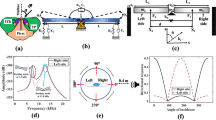Abstract
The human ear receives the sound signals from the ambient and converts those signals to the electrical domain and transmits them to the brain. According to the prevalence of human hearing impairments and necessity of using the hearing aid, this paper has been concentrated on the design of microphones to be implanted inside the ear. The intended design for this application is using microelectromechanical technology and piezoelectric material. Based on the important role of the diaphragm in the microphones structure and in order to achieve maximum displacement in diaphragm, variety of accurate studies in terms of shape and dimension have been done and will be presented in this paper. The examined shapes for selecting the optimum diaphragm’s form are circle, square and hexagonal. In the performed simulations and analysis, four dimensions in micrometer have been considered for each selected shape. According to the contemplated the efficiency parameters (diaphragm’s center displacement, first resonant frequency) and results of the simulations, the circular diaphragm’s performance with dimension of 350 µm compared to the other cases is desirable for medical application of the microphone. The analysis and simulations have been performed in COMSOL software. The fabrication process of the proposed diaphragm has been done using bulk and surface micromachining. In addition, AlN was utilized as the piezoelectric material in this structure.










Similar content being viewed by others
References
Cheng TY (2010) The sensitivity analysis of a MEMS microphone with different membrane diameters. J Mar Sci Technol 18(6):790–796
Donaldson James A (1992) Anson-Donaldson: surgical anatomy of the temporal bone, 4th edn. Lippincott Williams & Wilkins, USA
Gabrielson TB (1993) Mechanical-thermal noise in micromachine acoustic and vibration sensors. IEEE Trans Electron Devices 40(5):903–909
Gyo K et al (1990) Present status and outlook of the implantable hearing aid. Am J Otol 11(4):250–253
Han C, Kim E (1999) Fabrication of dome-shaped diaphragm with circular clamped boundary on silicon substrate. In: Proceedings of the IEEE Conference MEMS, Orlando, USA, pp 505–510
Haynes S et al (2012) Ear implantable hearing devices: an overview. Trend Amplif 13(3):206–214
Ko S et al (2003) Micromachined piezoelectric membrane acoustic device. Sens Actuators 103:130–134
Kuhnel W (1992) Micromachined subminiature condenser microphones in silicon. Sens Actuators 32:560–564
Lee S et al (1996) Piezoelectric cantilever microphone and microspeaker. J Microelectromech Syst 5:238–242
Littrell, R (2010). High performance piezoelectric MEMS microphone, aissertation submitte in partial fulfillment of the requirements for the degree of doctor of Philosophy in the university of Michigan
Liu, J (2007). Nonlinear dynamics of a dual backplate capacitive MEMS microphone. Doctor of philosophy. University of Florida
Neumann J et al (2002) CMOS-MEMS membrane for audiofrequency acoustic actuation. Sens Actuators 95:175–182
Niu M (2003) Piezoelectric bimorph microphone built on micromachined parylene diaphragm. J Microelectromech Syst 12:892–898
Oliveira RJ (1997) The active ear canal. J Am Acad Audiol 8(6):401–410
Pavey CR, Burwell CJ (1998a) Bat predation on eared moths: a test of the allotonic frequency hypothesis, vol 81. Wiley, New York, pp 143–151
Pavey CR, Burwell CJ (1998b) Bat predation on eared moths: a test of the allotonic frequency hypothesis, vol 81. Wiley, USA, pp 143–151
Roeser RJ, Ballachana BB (1997) Physiology, pathophysiology, and anthropology/epidemiology of human ear canal secretions. J Am Acad Audiol 8(6):391–400
Seob L et al (2008) Piezoelectric microphone built on circular diaphragm. Sci Direct/Sens Actuators 144:367–373
Sheplak M, Dugundji J (1998) Large deflections of clamped circular plates under initial tension and transitions to membrane behavior. J Appl Mech 65(1):107–115
Sowell A (1983) The bat’s ear as a diffraction grating. Master’s thesis, Accession number: ADA164098, Pagination or media count: 83
Suyog M et al (2012) An aid hearing for stone deaf person. Inter J Eng Sci Technol (IJEST) 4(04):1544–1552
Timoshenko S, Krieger SW (1959) Theory of plates and shells. McGraw-Hill, New York, pp 396–404
Vujanic A, Pavelka R, Adamovic N, Kment Ch, Mitic S, Brenner W, Popovic G (2002) Development of a totally implantable hearing aid. In: Proceedings of the 23rd International Conference on Microelectronic pp 235–238
Yi S, Kim E (2002) Piezoelectric microspeaker with compressive nitride diaphragm. In: Proceedings of the IEEE Conference MEMS, Las Vegas, USA, pp 260–263
Zarifi MH, Frounchi J, Farshchi S, Judy JW (2010) A novel time-based low-power pipeline analog to digital converter. Analog Integr Circuits Signal Process 62(3):281–289
Zarifi T, Chung-Ching Peng, Zarifi MH (2011) Low-power amplifier for in vivo EEG signal recording. In: 1st Middle East Conference on Biomedical Engineering (MECBME), pp 19, 22, 21–24 Feb. 2011
Zarifi MH, Frounchi J, Tinati MA, Farshchi S, Judy JW (2011b) A low-power small-area 10-bit analog-to-digital converter for neural recording applications. Int J Circ Theor Appl 39:385–395
Author information
Authors and Affiliations
Corresponding author
Rights and permissions
About this article
Cite this article
Zargarpour, N., Zarifi, M.H. A piezoelectric micro-electromechanical microphone for implantable hearing aid applications. Microsyst Technol 21, 893–902 (2015). https://doi.org/10.1007/s00542-014-2134-7
Received:
Accepted:
Published:
Issue Date:
DOI: https://doi.org/10.1007/s00542-014-2134-7




